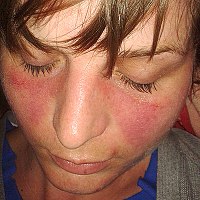
Photo from wikipedia
Sir, We read with great interest the article by Chanprapaph et al. on the association of bullous (B) systemic lupus erythematosus (SLE) and some systemic manifestations of the disease, and… Click to show full abstract
Sir, We read with great interest the article by Chanprapaph et al. on the association of bullous (B) systemic lupus erythematosus (SLE) and some systemic manifestations of the disease, and would like to congratulate the authors on their work. In this single-center university-based hospital (Ramathibodi Hospital, Mahidol University, Bangkok, Thailand) study, 5149 patients with cutaneous lupus erythematosus and/or SLE were followed from 2002 to 2014. Only 10 patients (0.19%) were diagnosed with BSLE with a median age at disease onset of 24 years (7–68 years). In 6 of these 10 patients, BLSE occurred at a median of 2.5 months (0–89) after SLE diagnosis, while in the remaining 4 bullous lesions developed as the initial manifestation of SLE. Interestingly, all 10 patients presented hematologic abnormalities while renal involvement occurred in 9 of the 10. Polyarthritis and serositis occurred less frequently. In view of these findings, we decided to examine the GLADEL database. GLADEL is an inception longitudinal cohort from nine Latin American countries that is constituted by Mestizo, Caucasian and African Latin-American patients. Six (0.41%) patients were diagnosed with BSLE in our cohort. Within this cohort of 1480 patients, we carved a case-control study, matching patients for age, gender and center in a 1:3 proportion. The demographic, clinical features, laboratory findings, treatment and outcomes of cases and controls were examined; these data are depicted in Table 1; three of these six cases developed BSLE before the diagnosis of SLE; all six patients were women with a median age at SLE diagnosis of 22.5 years (Q1–Q3 20.0–30.0). Of interest, all our patients had hematologic abnormalities (leukopenia being the most representative) and that was the case for nearly all the controls. Most importantly, all but one (83.3%) of the cases exhibited renal involvement, according to the ACR renal criterion, versus 7 (38.3%) of the 18 controls. By Fisher’s exact test, significance was not reached. Furthermore, 3 of the 6 cases died versus 4 of the 18 controls. Along these lines, de Risi-Pugliese, et al. have recently described the occurrence of lupus nephritis in 50% of 128 BLSE cases (118 collated from the literature and 10 new cases of their own); they indicated that the association of BLSE and lupus nephritis represents a subset of a more aggressive disease. The main limitations of our report relate to the fact that BSLE was diagnosed clinically, and that renal biopsy data were available in only two of the affected patients. In addition, the small number of patients studied accounts for the lack of statistical significance for some of the comparisons reported. In contrast with discoid lupus erythematosus (DLE), which we have found to reduce the risk of
Journal Title: Lupus
Year Published: 2018
Link to full text (if available)
Share on Social Media: Sign Up to like & get
recommendations!